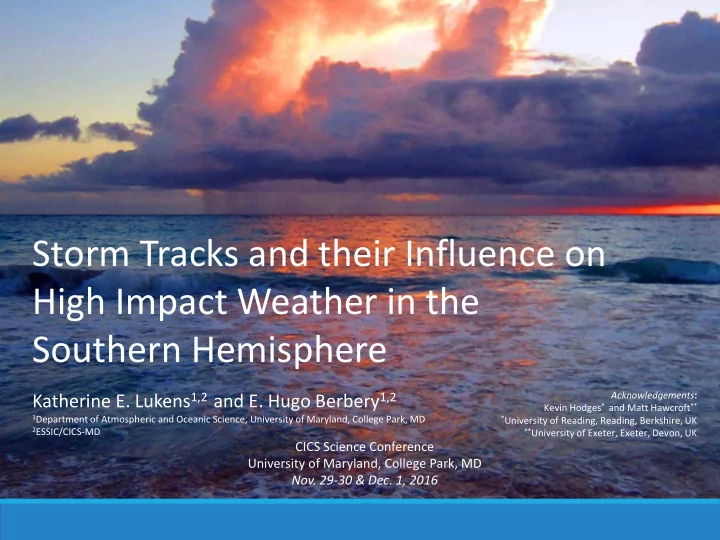

Storm Tracks and their Influence on High Impact Weather in the Southern Hemisphere Acknowledgements : Katherine E. Lukens 1,2 and E. Hugo Berbery 1,2 Kevin Hodges * and Matt Hawcroft ** 1 Department of Atmospheric and Oceanic Science, University of Maryland, College Park, MD * University of Reading, Reading, Berkshire, UK 2 ESSIC/CICS-MD ** University of Exeter, Exeter, Devon, UK CICS Science Conference University of Maryland, College Park, MD Nov. 29-30 & Dec. 1, 2016
Outline Background Objectives and Goal Dynamics of Storm Tracks Effects on High Impact Weather Reanalysis vs. Observations
Background • Storm Tracks (STs) are narrow bands of baroclinic instability along which storms tend to propagate. They exist near regions of large cyclonic shear poleward of the upper tropospheric jet stream that promote the growth and intensification of unstable baroclinic waves and cyclones. • The jet stream along with other forcings like SSTs, land-sea temperature contrasts, and orography influence the strength and distribution of STs . • The STs in the Southern Hemisphere (SH) lie coincident with the subtropical and subpolar jets and are maintained year-round in part by the large zonal symmetry resulting from the expansive oceans and overall lack of landmass.
Objectives Goal 1. To understand the dynamic -To provide guidance in seasonal factors behind the evolution of forecasting of severe storms and severe storms in the Southern high impact weather in the Hemisphere winter (JJA). Southern Hemisphere. 2. To examine how severe storms influence low-level wind and precipitation distributions, especially near populous areas. 3. To examine how well the ingested CFSR represents observed storm precipitation.
Methodology A cyclone-tracking approach is used to • identify isentropic potential vorticity (IPV) minima on the θ =320K surface from CFSR as individual storms and follow their evolutions. To be considered a storm, each cyclone must: • Have a min intensity less than -0.5 PVU (1 PVU o = 10 -6 K m 2 kg -1 s -1 ). Last at least 2 days. o Travel farther than 1000 km. o Ex) Severe Storm Trajectories
SH Storm Tracks The mid-latitude storm track spans all longitudes with a secondary track south of • Australia toward the Ross Sea. Cyclones per month per 10 6 km 2
Mean ST Intensity STs are strongest over the oceans and upwind of high orography. •
Cyclogenesis & Cyclolysis Cyclogenesis and cyclolysis regions are revealed. • Cyclones per month per 10 6 km 2 Cyclones per month per 10 6 km 2
Diabatic Heating & Severe STs • Severe storms make up 14% of all winter cyclones. • Net diabatic heating increases in the storm track regions when severe storms are present. • Deep convection dominates over the oceans where the severe STs are most intense. ST DiabHeat K day -1 K day -1 ST DiabHeat – No-ST DiabHeat
High Impact Weather 850hPa Winds • Severe storms Shift the winds northeastward. • • Increase low-level wind speeds (a) where deep convection dominates, and (b) leeward of high orography. ST Low-level Winds m s -1 m s -1 ST Winds – No-ST Winds
High Impact Weather Precipitation • Severe STs provide about 40% of the precip contributed by all storms. Mean Total Precip 1980-2010 mm day -1 Severe ST Contribution to Mean Storm Precip %
Reanal alysis vs. Ob Observations The precip structure is consistent between the reanalysis and observations (GPCP, taken • as “ground truth”). Mean Total CFSR Precip 1999-2010 mm day -1 Mean Total GPCP Precip 1999-2010 mm day -1
Reanal alysis vs. Ob Observations Severe STs provide comparable fractions of total precip using both datasets. • Severe ST Contribution to Storm Precip from CFSR % Severe ST Contribution to Storm Precip from GPCP %
Conclusions 1. The mid-latitude and subpolar STs on the 320K isentrope are consistent with past studies. 2. STs are most intense over the oceans and upwind of high orography. 3. Severe storms intensify the low-level winds (a) where deep convection dominates and (b) leeward of high orography, particularly east of the Andes Mountains. 4. Severe storms provide almost half of the precip contributed by all storms. 5. Reanalysis precip associated with storms is consistent with observations.
Thank you! Questions? Email : klukens@umd.edu
Supplemental STs and Mean Zonal Wind 1980-2010 Cyclones per month per 10 6 km 2 Mean Zonal Wind at 200mb m s -1
Supplemental Properties of STs for 1999-2010 Track Density 1999-2010 Cyclones per month per 10 6 km 2 Mean ST Intensity 1999-2010
High Impact Weather Precipitation • Severe STs provide about over 15% of the total mean precip. Mean Total Precip 1980-2010 mm day -1 Severe ST Contribution to Mean Total Precip %
Supplemental Reanalysis vs. Observations Severe STs provide more reanalysis precipitation than is observed, particularly along the • southwestern coast of South American. CFSR Precip related to STs mm day -1 GPCP Precip related to STs mm day -1
Reanalysis vs. Observations Severe STs provide comparable fractions of total precip using both datasets. • ST Contribution to Mean Total CFSR Precip % ST Contribution to Mean Total GPCP Precip %
Recommend
More recommend